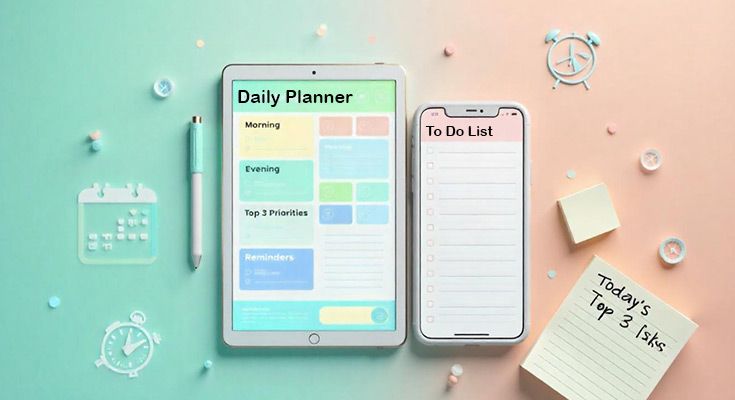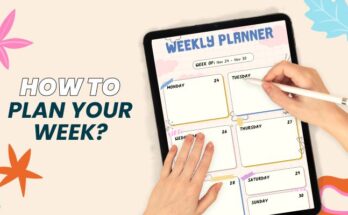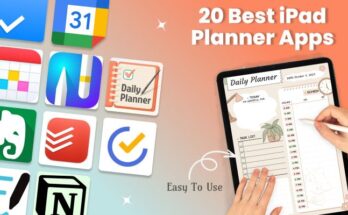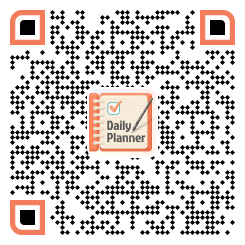Planning your day in under 10 minutes with a simple daily planning system. By brain-dumping your tasks, prioritizing your top goals, and time-blocking efficiently using a daily planner app, you can set up a productive, focused day faster than brewing a cup of coffee. This guide will show you exactly how to plan your day quickly, without feeling overwhelmed.
Why a Daily Planning System Matters.
Planning your day isn’t just about checking off tasks, it’s about creating clarity and reducing overwhelm. A daily planning system saves hours by helping you focus on what matters most. Research shows that structured planning improves productivity by up to 25% and reduces stress by keeping you in control of your time. Without a plan, you’re more likely to waste time on low-priority tasks or feel swamped by endless to-dos.
Here’s why a quick daily planning system is a game-changer:
- Clarity: Know exactly what to tackle first.
- Efficiency: Spend less time deciding and more time doing.
- Balance: Make room for work, personal goals, and rest.
How to Plan Your Day in Under 10 Minutes (Step-by-Step)
You don’t need hours or fancy apps to plan your day. This daily planning system is designed to be simple, scalable, and fast, perfect for beginners. Follow these five steps to build a fast productivity setup in under 10 minutes using a notebook, daily planner templates, or an app. Whether you’re juggling work, school, or personal tasks, this system ensures clarity and control without stress.
How to Plan Your Day: Step-by-Step Guide
1: Brain Dump Your Tasks (2 minutes)
2: Prioritize Top 3 Tasks (2 minutes)
3: Time Block Key Activities (3 minutes)
4: Set Quick Micro Goals (2 minutes)
5: Review and Adjust (1 minute)
Step 1: Brain Dump Your Tasks (2 minutes)
Before you can plan a focused day, you need a clear mental landscape. This step is about unloading every task, idea, or reminder floating in your head.
How to do it:
- Set a timer for 2 minutes — this adds urgency.
- Quickly list everything — work, errands, personal projects, even tiny chores like “buy dog food” or “email John.”
- Don’t organize. Don’t judge. Just write.
Why it matters:
- Your mind holds dozens of micro-tasks at once, draining energy without you noticing.
- By offloading them onto paper or to do planner templates (or an app like Todoist, or even a sticky note), you immediately free up brain space for higher-level thinking.
Tip for beginners: If you’re stuck, mentally walk through your day:
- Morning (Emails, Meetings)
- Afternoon (Client work, Errands)
- Evening (Meal prep, Personal projects)
The goal is quantity, not quality. Capture first, organize later.
Step 2: Prioritize Top 3 Tasks (2 minutes)
Not everything you wrote down deserves your focus today. Prioritization is the secret weapon of fast, effective planners.
How to do it:
- Review your brain dump.
- Pick only three Most Important Tasks (MITs) for today.
- Choose tasks that are urgent, important, or impactful (using the Eisenhower Matrix can help if you’re unsure).
Example:
- Urgent: Submit project proposal by 5 PM
- Important: Draft blog article for website
- Impactful: Call top client for feedback
Why limit to 3?
- Because human willpower is finite. Trying to do 8–10 “priorities” is a myth; true productivity comes from laser focus. Using task planner templates can help streamline your task prioritization and provide a clear framework to stay organized.
Pro Tip: Use bold colors (red marker, star icon, etc.) to visually separate your MITs from the rest.
Step 3: Time Block Key Activities (3 minutes)
Now, it’s time to transform your priorities into action by placing them into your schedule.
Simple Time Blocking Process:
- Assign specific time slots for your MITs first.
- Group small, similar tasks into one block (ex, emails, admin).
- Add 15–30 minute buffers between major tasks to handle surprises.
Example of a Daily Time Block:
- 8:00–9:30 AM: Write presentation slides (MIT #1)
- 9:30–10:00 AM: Break + Inbox check
- 10:00–11:30 AM: Strategy meeting (MIT #2)
- 11:30–12:00 PM: Administrative tasks (batch)
Why Time Blocking Works:
- Minimizes context switching
- Creates momentum by reducing “what should I do now?” decisions
- Protects your creative and deep focus hours
Pro Tip: If your day is unpredictable (meetings, calls, etc.), create “protected hours,” a small window where no interruptions are allowed.
Step 4: Set Quick Micro Goals (2 minutes)
Big tasks can feel intimidating. That’s why you must break MITs into bite-sized micro-goals, tiny wins that trigger momentum.
What a micro-goal looks like:
- Instead of: “Work on marketing report”
- Set: “Complete 1st page of report” or “Write 100 words”
Why micro-goals boost productivity:
- They help you start faster (the hardest part)
- They create small dopamine hits as you finish each subtask
- They reduce procrastination by making goals seem achievable
Best practice:
- Frame micro-goals around visible progress, not vague effort.
- (Writing 2 emails is better than working on emails.) Using goal planner templates can help break your larger objectives into smaller, actionable steps, making it easier to stay on track and measure progress.
Step 5: Review and Adjust (1 minute)
Finally, take a moment to review your day plan and tweak anything unrealistic.
Quick Review Checklist:
- Are your top 3 tasks achievable with today’s available time?
- Did you leave enough breathing room between tasks?
- Have you scheduled small breaks to avoid burnout?
- Did you overestimate how much you can realistically accomplish?
If necessary, move non-essential tasks to tomorrow or shrink big tasks into smaller chunks.
Remember: Planning is not about rigid perfection, it’s about a realistic structure that gives you control, not stress.
Choosing the Right Tools for Your Daily Planning System
A daily planning system doesn’t require complex tools. Whether you prefer analog or digital, the right tool enhances your fast productivity setup. Here’s a breakdown of options to suit any lifestyle:
- Paper or digital Planners: Ideal for tactile learners who enjoy writing. Use a notebook, our planning template, portable way to map out your day.
- Digital Apps: Apps like PlanWiz, Google Calendar, or Notion offer reminders and syncing. They’re great for tech-savvy users or those with dynamic schedules.
- Hybrid Approach: Combine paper for priorities and apps for notifications. For example, write MITs in a planner and set calendar alerts for meetings.
Choose a tool that feels intuitive and supports quick planning. No tool? No problem—our planning template works with any notebook.
Common Mistakes to Avoid When Planning Quickly
Even the best daily planning system can fail if you fall into common traps. Avoid these beginner mistakes to keep your plan effective:
- Overloading Your Schedule: Planning 20 tasks in a day is unrealistic. Stick to 3–5 key tasks to stay focused.
- Skipping Breaks: Without buffers, you’ll burn out. Schedule 10–15-minute breaks between time blocks.
- Ignoring Flexibility: Life is unpredictable. Leave 30–60 minutes unscheduled for unexpected tasks or delays.
By sidestepping these pitfalls, your daily planning system will remain practical and sustainable. Reflect weekly to identify patterns and refine your approach.
Tips to Make Your Fast Planning Habit Stick
To ensure your 10-minute daily planning system becomes a habit that works consistently, here are several strategies that will help reinforce and solidify it:
Plan at the Same Time Every Day
- Consistency is key when it comes to building a new habit.
- Choose a specific time each day, whether it’s first thing in the morning or at night before bed, and make it part of your routine.
- This removes the mental effort of deciding when to plan, making the process automatic over time.
Keep Your Setup Simple
- Overcomplicating your planning process will lead to frustration and resistance.
- Keep your tools and system simple.
- Use tools you’re already comfortable with, like a paper planner or simple apps (like PlanWiz, Google Calendar, or even a physical notebook).
- Avoid jumping into complex apps with too many features that might overwhelm you.
Use Visual Triggers
Create visual reminders to prompt your daily planning habit.
- Sticky notes on your desk or computer can remind you to plan your day.
- Set calendar alerts to go off every day at your chosen time.
- Place a vision board or motivational quote near your workspace as a gentle nudge to stick to your routine.
Reward Yourself After a Successful Day’s Plan
- Celebrate your wins!
- After completing your daily planning session, treat yourself to a small reward.
- This could be something as simple as a cup of your favorite coffee, a 5-minute break, or listening to your favorite song.
Final Thoughts
A daily planning system transforms chaos into clarity in just 10 minutes. By prioritizing tasks, using PlanWiz planner templates, and adopting a fast productivity setup, you’ll boost productivity, reduce stress, and make time for what matters. Whether you’re juggling work, family, or personal goals, this system scales to fit your life. Start today and experience the power of planning.
Also Read
How to Organize Your Day Effectively (Without Overwhelm)
People Also Ask
Follow a structured system: brain dump tasks, prioritize your top 3, time block key activities, set small goals, and quickly review — all under 10 minutes.
A daily planning system that combines brain dumping, prioritization, and time blocking is highly effective for organizing tasks.
Ask: “Which 3 tasks, if completed today, will make the biggest impact?” Focus on these first.
A simple 5-step system: capture, prioritize, schedule, set micro-goals, review.
Use fast productivity setups like time blocking and keep your to-do list to no more than 5 major tasks per day.








